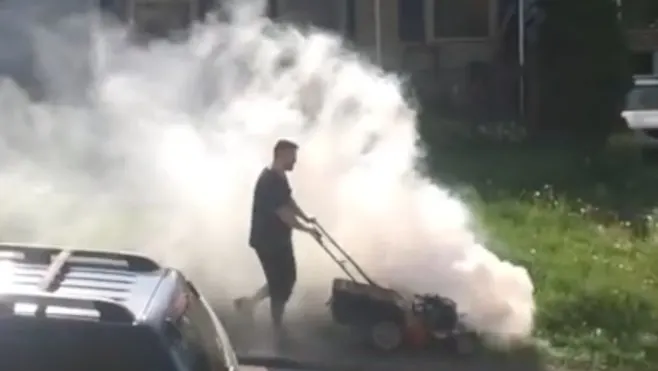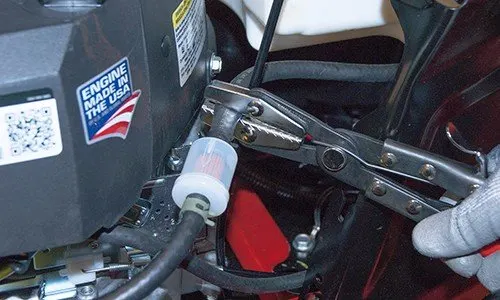Does your lawnmower seem to be losing power or not starting at all? The problem might lie in a clogged fuel filter. Our comprehensive guide will walk you through cleaning and getting your lawnmower up and running quickly.
To clean a lawnmower fuel filter, disconnect the fuel lines, drain the fuel, remove the filter, and spray cleaner. Let dry, then reinstall appropriately oriented. Reconnect fuel lines and test engine. Replace paper filters. Consult the manual for model specifics.

Don’t let a clogged fuel filter slow you down. Discover how to clean your lawnmower’s fuel filter and restore its power in our comprehensive guide.
Contents
- 1 Signs of Clogged Fuel Filters
- 2 Cleaning Lawnmower Filters: How to Do It?
- 3 Replacing Fuel Filters: What You
Need To Know and How to Do It
- 3.1 – Identifying Symptoms of a Clogged Filter
- 3.1.1 – Park the lawnmower:
- 3.1.2 – Use the right gear:
- 3.1.3 – Loosen the filter:
- 3.1.4 – Examine the filter for faults:
- 3.1.5 – Install the new filter:
- 3.1.6 – Clamp the fuel lines:
- 3.1.7 In my 20 years of experience, I’ve found that difficulty starting the engine, poor engine performance, and decreased fuel efficiency can all be signs that a lawnmower fuel filter needs cleaning.
- 3.1.8 – Consulting Your Seller/Manufacturer for Advice
- 3.1 – Identifying Symptoms of a Clogged Filter
- 4 What is the cost of cleaning/replacing dirty fuel filters?
- 5 Can you save money when replacing paper/nylon filters?
Signs of Clogged Fuel Filters
The answer is simple for those who do not know the location of a fuel filter in lawnmowers. It varies from one mower model to another. You can locate it on the fuel line leading to the combustion chamber (carburetor) or the fuel tank.
When diagnosing clogged filters, start by taking a keen interest in the engine. Does it spit? Does the exhaust pipe produce dark fumes with a foul smell? If your answer to these questions is affirmative, the fuel filter could be the culprit due to clogging.
The bottom line is that bad filters have a direct impact on the health of the engine, so here are signs of clogging you should note:
● Lawnmower Engine Stalls when Accelerating:
When accelerating, more fuel goes through the filter and finally into the combustion chamber. However, should the engine lose its power and stall when accelerating, the chances are high that the fuel filter is terrible.
Clogged filters prevent sufficient fuel flow to the engine, hence the occasional stalling when mowing at high speed. We, therefore, recommend that you diagnose the one in your lawnmower for debris and other particles such as rust and dust.
Based on my two decades in the field, I recommend cleaning a lawnmower fuel filter at least once every season, although this can vary depending on usage
● Engine Misfiring Randomly:
Another symptom of a clogged filter is when a lawnmower engine starts misfiring. If the machine does not stumble, your service provider should diagnose for error codes. Misfiring engines mean injectors are not getting enough fuel, hence the need to diagnose filters for clogging.
Note that unless you have one of the latest models of lawnmowers, misfiring should not happen when a lawnmower is parked in gear. The only incident during parking that could further signal filter clogging is the rough idling of the engine.
● No Engine Power:
When less or no fuel goes through injectors, you should expect the engine in your lawnmower to lose its power. Right away, park your machine, then diagnose fuel filters for clogging. You will see an error code on the dashboard with most modern mowers.
It usually happens as soon as the engine goes into limp mode. However, do not overrule the possibility of a fault in the injectors. Sometimes, injectors will give you the wrong signal, making you think that filters are under heavy clogging.
Diagnosis should include other components that connect filters to the engine and carburetor.
• Physical Diagnosis of the Fuel Filter in a Lawn Mower:
You can physically diagnose your lawnmower for filter clogging. To do it, blow as much air as you can through the fuel-in nozzle. There is clogging if air does not come out through the fuel-out nozzle. Replacement or cleaning, therefore, becomes necessary.
● Engine Fails to Start:
Engines that fail to start are not always as faulty as most people would want to believe. You could end up wasting time diagnosing a healthy carburetor or injector. It is often said that clogged filters cause problems in lawnmower engines, and failed ignition is one of them.
Whether the engine jerks or fails to start, check fuel filters for partial or complete clogging.
● Smelly Fumes:
Do exhaust fumes produce a foul smell? If that is the case, check the filter for clogging. The most likely outcome would be affirmative, hence the need to clean or replace it with a new one.
With the signs of clogged filters at your fingertips, you should start cleaning. But when replacing filters is necessary instead of cleaning them, stay tuned for guidelines later in this post.

Cleaning Lawnmower Filters: How to Do It?
Dirty fuel is a sign of clogged filters. But the question is, do you know how to clean the fuel filter in your lawnmower? For a novice, you should get help from lawn mowing service providers.
But the catch is that cleaning filters at least twice a year should help improve their efficiency in cleaning the fuel that goes into the engine. And when it comes to replacing worn-out nylon or metallic filters, we recommend doing it once every year.
Now, on how to clean these gadgets, we did some homework and put together the following guidelines:
• Park your lawnmower on a flat surface:
To start cleaning, park your lawnmower on a flat surface, preferably a parking yard or garage. Parking your machine in an open space is one of the many precautionary measures you should take to avoid fire accidents. Remember to wear protective clothing.
• Remove the fuel pump fuse:
Next, remove the fuel pump fuse, assuming you know where to find it. With that, it is time to remove pressure from the fuel system by letting the engine run for about two minutes.
• Disconnect battery terminals:
Disconnect the terminals, preferably the negative ones. You could refer to it as removing the spark plug, but the motive is to prevent a fire from a hazard. The risk of not pulling the spark plug is that the engine might start on its own, or gas fumes might ignite in the fuel system.
• Disconnect the fuel lines:
Next, using a screw wrench, disconnect the fuel lines. Put on protective eyeglasses when performing this task. Accidental fuel spillage could prove detrimental to your eyesight.
• Remove the filter:
Now, it is time to eject the filter. When doing so, please take note of its seating to avoid wrong re-installation. Many people ask this question: What happens when you install filters wrongly? Will fuel flow in the opposite direction? We will tackle these questions later on in this post. For now, the good news is that some fuel filters have labeling that indicates the direction of installation, so it is only a case of flicking it back into position.
• Cleaning a clogged fuel filter:
Cleaning a clogged filter should take about 10 to 15 minutes. In cases of partial clogging, five minutes is enough. Start by draining fuel/dirt/debris residue by tapping the filter on both ends (fuel-in, fuel-out nozzles). Be gentle at it and drain fuel filter residue into a container.
• Use a good cleaner:
Always use a good cleaner, preferably for carburetors, when unclogging lawnmower fuel filters. Spray it inside and outside, then tap both ends one more time. Leave the filter in the open air to dry, say for an hour or two.
Safety Precautions to Consider when Cleaning Filters
You would rather be safe than sorry when cleaning dirty fuel filters. Thus, take preventive measures at all times. Wear protective gear, preferably clothes you won’t mind getting tainted with oil/fuel. Protective glasses are equally necessary to guard your eyes.
Moreover, always pull off spark plugs. You don’t want to end up in a situation where the mower starts independently while working on the filters.
In a nutshell, leaving spark plugs on is a recipe for an accident and fire hazards. You can always contract a lawnmower service provider to help clean filters if you are a first-timer.

Replacing Fuel Filters: What You Need To Know and How to Do It
We indicated earlier that the best thing you should do with paper and nylon filters is to replace them as soon as signs of clogging appear. But the begging question is, do fuel filters have a lifespan? Well, in most cases, replacing filters every two years is a good rule of thumb.
Alternatively, you can have a mechanic diagnose the fuel lines to determine if there is a problem with the filter before taking any action. Some mechanics recommend that filter replacement occur after every 20,000 miles of mowing.
Of course, that will depend on how often you use your lawnmower, but a pressure test should further help resolve any misgivings. While mileage is essential, it should not be a rule of thumb. This is because some manufacturers recommend cleaning filters only after clocking 30,000 miles in mowing.
– Identifying Symptoms of a Clogged Filter
A pressure test aims to determine the amount generated at the fuel rail. Low or reduced pressure, often below 30 psi, is a signal that there is clogging in the filter. The engine’s health will be at risk when you don’t replace faulty filters.
Moreover, regardless of the filter location, you should be wary of idling problems with the engine, including other symptoms of clogging we explored earlier. We also advise checking product user manuals for filter cleaning and replacement.
It would be best if you did not risk doing something because every homesteader does it; instead, knowing every filter manufacturer has specific rules is an essential step as we advance.
Now, when it comes to replacing faulty or clogged paper/nylon filters, it should take only a few steps. They include:
– Park the lawnmower:
Park the lawnmower on a flat, hard surface, then let the engine cool down.
– Use the right gear:
Wear proactive gloves, then use a screw wrench to remove the fuel lines that connect the filter to the engine/combustion chamber. You can also use a pair of pliers. When removing the filter, ensure there is a plastic container underneath into which fuel residue will run.
– Loosen the filter:
Move the fuel lines away from the filter by slight outward sliding on both ends. Now, loosen the filter by twisting it slightly as fuel residue drains into a container.
– Examine the filter for faults:
Diagnose the filter for any faults and compare it with the new one before deciding whether to replace or clean it (for metallic filters). It would be best to replace paper filters immediately because they are hardly reusable.
– Install the new filter:
When installing a new one, ensure it flicks back tightly into position and in the right orientation. The good news is that most filters have labels indicating the direction of installation.
– Clamp the fuel lines:
Slide back the clamps holding the fuel line into the nozzles on both ends of the filter, tighten them, and wipe them clean.
In my 20 years of experience, I’ve found that difficulty starting the engine, poor engine performance, and decreased fuel efficiency can all be signs that a lawnmower fuel filter needs cleaning.
– Consulting Your Seller/Manufacturer for Advice
Once you follow the above steps to the letter, power on your mower, then run it to test the filters again. Does the engine jerk? Does the engine misfire or fail to start? Should you spot any of these problems, the chances are high that the new filter is faulty or you missed a step in the installation/cleaning procedure.
We recommend you consult your seller/manufacturer or service provider for further advice. You should also note that the procedure for removing filters sometimes varies depending on the type of lawnmower- a push or riding mower.
What is the cost of cleaning/replacing dirty fuel filters?
Before diagnosing lawnmower fuel filters for clogging, you may want to ask a few questions. For example, what is the cost of cleaning filters if you hire a lawn service provider? Also, how much does a new filter cost if you go the replacement way?
For those who mow less often, say, during spring only, fuel filter maintenance costs are significantly low. However, if you run a mowing business, cutting grass over several miles of lawn daily costs more money, especially in maintenance costs.
The catch here is that machines wear and tear out fast with frequent use, so you should expect filters to clog faster when you are mowing frequently. To clean or replace the filter, disconnect the negative terminal from your engine and remove the filter from the fuel lines.
– Preparing the Filter for Cleaning
Place the filter in a prepared container and spray it with a cleaning solution. Let it sit for a while, then tap out any debris. If any gas remains in the filter, make sure it drips out. After cleaning, reinstall it back into your engine and run it for a few minutes to check if it works properly.
Moreover, cleaning or replacement costs can vary depending on the extent of damage to the fuel line and the engine. It means you may also have to clean or replace other parts in the processing of unclogging filters.
Since cleaning filters call for a routine maintenance practice, doing it alone will save you some bucks. But if you hire a service provider, charges could go higher depending on the company you contract for the task.
– Understanding the Cost of Replacement Filters
We did a quick online search and found that replacement costs average between $5 and $200. You can get a brand new filter at Walmart for at least $6 or at most $45. Mr. Tire will charge you money in the range of $70 on the lower side or $215 on the higher side.
We also compared prices on Amazon and noted that an excellent spare filter should cost you $110 on the higher side or $8 on the lower side. Remember that these prices vary depending on, among other things, model manufacturer and shipping costs.
In my career, I’ve seen common mistakes like over-tightening the filter, not cleaning it regularly enough, and not following safety precautions when cleaning a lawnmower fuel filter.
Can you save money when replacing paper/nylon filters?
Yes, you can save money on filter replacement. After buying the best fuel filter for your lawnmower, we know how much it means to have a few extra bucks in your pocket. Pure bliss! You should, therefore, do the following:
- Buy a replacement filter: Get a tiny replacement filter during annual lawnmower servicing as part of the maintenance and care routine, which saves money. If your service provider does not charge extra money for cleaning, that’s better.
- Check for affordable prices: Besides cleaning clogged filters, change is as good as necessary. Thus, shopping around for the best prices is another way to save money on a new filter replacement. Check out prices on Walmart, eBay, manufacturer websites, and Amazon, including shipment cost, before deciding on the cheapest or most affordable option.
- Consult the manufacturer: Consult your lawnmower’s manufacturer on cleaning/changing fuel filters. They may offer an alternative solution that saves money, such as aftermarket spares instead of OEM accessories.
The bottom line is that cleaning and replacing these vital components of your riding or push mower is a pretty straightforward process. If you want to save more money, doing everything at home is the best bet. It is incredibly workable if you will not need the input of a specialist.
Moreover, avoid ordering the wrong replacement filters before consulting repair specialists or the manufacturer of your mower. You don’t want to damage your machine because of ignorance.
What happens if you wrongly install a fuel filter after cleaning?
Lawnmower fuel filter installation should be a pretty simple process. However, sometimes mistakes happen. Take, for example, installing a filter backward. What would happen? Will fuel flow normally or could it trigger a severe engine failure?
These questions can continue, but let’s admit that lawnmower fuel filters vary in design. While most, if not all, have a direction of installation indicated on the gadget, there are instances where installation can take place backward, and nothing terrible would happen to your push or riding mower. However, it would be best if you noted a few signs that may indicate the wrong filter installation. They include:
- Installing the filter in reverse: In some cases, installing filters backward stops or restricts fuel flow. You may have to open the gadget to check the arrangement of filters to determine whether installing it in any direction is okay.
- Access the engine after installation: Test the engine as soon as you finish installing filters. Should it fail to start, you may have to remove the filters and re-install them correctly.
- Pump failure: Sometimes pump failure signals wrong filter installation.
With the above indicators at your fingertips, you would also want to ask how one installs fuel filters correctly.


Is it necessary to clean the fuel filter in a lawnmower often, or only when there are issues with the engine? How can I properly dispose of the fuel residue collected while cleaning the filter?
Hi Ann, to properly clean a lawnmower fuel filter, disconnect fuel lines, drain fuel, remove and spray the filter. Let dry, reinstall correctly, and dispose of fuel residue properly. Check the manual for specific instructions.
Are there specific tools needed to clean a lawnmower’s fuel filter?
To clean a lawnmower fuel filter, you can use basic tools such as a screw wrench and a good cleaner. Just follow the steps in our guide for a quick and easy process.
Can a clogged fuel filter cause permanent damage to a lawnmower’s engine?
Yes, a clogged fuel filter can cause permanent damage to a lawnmower’s engine. Regular cleaning is essential to prevent issues in the long run. Thanks for reading!
Great guide! Very detailed and easy to follow.
Thank you, Everett! I’m glad you found the guide helpful. Let me know if you have any more questions about cleaning lawnmower fuel filters.
I appreciate the step-by-step guide on cleaning the fuel filter. Very clear instructions.
Thank you, Herman Hart! I’m glad you found the step-by-step guide on cleaning the fuel filter helpful. If you have any more questions, feel free to ask.
What signs should I look for to know if my lawnmower’s fuel filter is clogged?
To know if your lawnmower’s fuel filter is clogged, watch for signs like engine stalling, misfiring, and lack of power. Follow our guide for cleaning steps.
Is it possible to clean a clogged fuel filter or is replacement always necessary?
Hi Nevaeh, it is possible to clean a clogged fuel filter in a lawnmower. Disconnect, drain, remove, clean, dry, reinstall, and test for improved performance. Check the blog post for more details.
I’m glad I came across this article. Very enlightening and informative.
Thank you, Marion! I’m glad you found the article helpful. If you have any more questions or need further assistance with your lawnmower, feel free to reach out.
I never knew cleaning the fuel filter was so important. Thank you for the insight.
Thank you for reading! I’m glad you found the information on cleaning the fuel filter helpful. Let me know if you have any more questions.
What are the common mistakes people make when cleaning or replacing the fuel filter in a lawnmower?
Thank you for your question, Martha! Common mistakes when cleaning/replacing lawnmower fuel filters include not orienting the filter correctly, failing to clean thoroughly, and not replacing paper filters. Follow our guide for best results.
How can I prevent my lawnmower’s fuel filter from getting clogged in the first place?
To prevent your lawnmower’s fuel filter from clogging, clean it every six months. Disconnect fuel lines, remove filter, spray cleaner, reinstall, and test. Replace paper filters if needed.
I will definitely be checking my lawnmower’s fuel filter after reading this.
Thank you, Glen! It’s great to hear that you found the information useful and will be proactive in checking your lawnmower’s fuel filter. Happy mowing!
These tips are invaluable for maintaining a healthy lawnmower engine.
Thank you, Marian Taylor! I’m glad you found the tips helpful for maintaining a healthy lawnmower engine. Happy mowing!
Is it safe to clean the fuel filter of a lawnmower if you don’t have much experience with maintenance?
To clean the fuel filter of a lawnmower, follow the step-by-step guide in our comprehensive post. Don’t let lack of experience deter you; with proper instructions, you can have your lawnmower running smoothly in no time.
Thank you for sharing this information, it’s really helpful.
Thank you, Darryl! I’m glad you found the information helpful. Let me know if there are any other topics you’d like to see covered.
How often should the fuel filter in a lawnmower be cleaned or replaced?
Hi Suzanne, to keep your lawnmower running smoothly, clean or replace the fuel filter at least once a year. Signs of clogs include stalling, misfiring, and loss of power. Follow our guide for step-by-step instructions.
Thank you for all the helpful tips and information. This article was a great read!
Thank you, Felix! I’m glad you found the article helpful. Let me know if you have any more questions.
Are there any specific brands of cleaning solution that are recommended for lawnmower fuel filters?
For cleaning lawnmower fuel filters, any brand of carburetor cleaner can be used to effectively remove debris and dirt. Make sure to let the filter dry completely before reinstalling.
This article has motivated me to take better care of my lawnmower. Thank you!
Thank you, Jamie! I’m glad the article motivated you to take care of your lawnmower. Remember to clean your fuel filter regularly to keep your mower running smoothly.
I had no idea that clogged fuel filters could cause so many issues. Very informative article!
Thank you, Gene! I’m glad you found the article informative. Let me know if you have any questions about cleaning your lawnmower’s fuel filter.
I will be bookmarking this article for future reference. So much helpful information!
Thank you, Bertha! I’m glad you found the article helpful. If you have any questions or need further assistance, feel free to reach out.